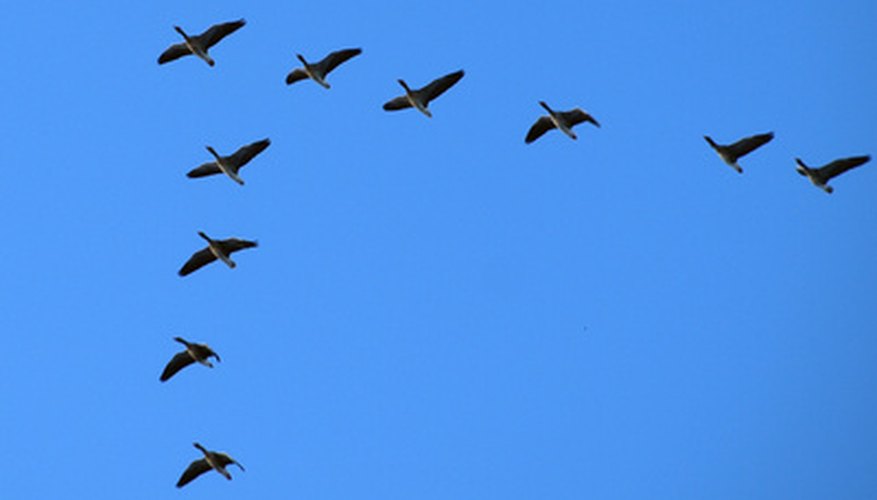The Canada goose often migrates seasonally in an effort to move to warmer, safer ground with more food sources. While these majestic birds are known for their V-shaped formation, not all Canada geese migrate and others do not migrate very far. Much of a goose's migration pattern is dependent on its family unit and annual moulting.
Moulting and Flight Feathers
Moulting is the act of shedding old flight feathers and growing new feathers. Each summer, adult geese shed their old flight feathers and begin to grow new ones. During this three- to four-week period, the birds are unable to fly. An adult goose's moulting period often coincides with the birth of goslings. Eggs are often laid in March or April and by the end of the summer, babies have grown their first set of flight feathers, according to the Humane Society of America's website.
- Moulting is the act of shedding old flight feathers and growing new feathers.
- Eggs are often laid in March or April and by the end of the summer, babies have grown their first set of flight feathers, according to the Humane Society of America's website.
Seasonal Migration
Typically the Canada goose engages in two seasonal migrations, each autumn and spring. According to the Ducks Unlimited website, the migration of the Canada goose is typically associated with a need for food. Grass has become a goose's primary food source and as the grasslands of the north freeze, geese travel south to more temperate climates. In the spring, geese travel along the same routes to return home to their starting point. Some Canada geese, known as resident geese, only migrate short distances unless severe weather forces them to leave, according to the Humane Society. Many geese find rest points along their migration route and may spend several days or weeks in a particular area before travelling further south, according the Wisconsin Department of Natural Resources.
- Typically the Canada goose engages in two seasonal migrations, each autumn and spring.
- According to the Ducks Unlimited website, the migration of the Canada goose is typically associated with a need for food.
Flyways
Annually, many flocks of geese will travel along the same routes, known as flyways. According to the Canadian Animals website, there are four main flyway routes that take geese from Canada into the United States. The Atlantic flyway is used by birds travelling south along the eastern coast of the U.S. Many birds follow the Mississippi River in a route known at the Mississippi flyway. The Central Flyway extends southward along the Rocky Mountain chains. The Pacific flyway takes birds west of the Rockies, along the United States' West Coast.
- Annually, many flocks of geese will travel along the same routes, known as flyways.
- The Atlantic flyway is used by birds travelling south along the eastern coast of the U.S.
- Many birds follow the Mississippi River in a route known at the Mississippi flyway.
Family Flights
Canada geese are very social birds, flying in flocks that resemble large, extended families. Geese are monogamous animals, mating for life, according to the Humane Society. Year after year they return to the same nesting sites and young goslings often stay with their parents for an entire year. Each fall, goose families assemble into large flocks. Birds fly in a large V-formation in an attempt to help all members of a flock reach their migration destination safely.
- Canada geese are very social birds, flying in flocks that resemble large, extended families.
- Year after year they return to the same nesting sites and young goslings often stay with their parents for an entire year.
Dangers
Along their migration journey, Canada geese face several dangers. Inclement weather such as heavy fog and snowstorms can jeopardise a goose's flight and navigation skills. Hunting is another serious threat to the safe arrival of migrating geese. Exhaustion and starvation may also cause some geese to be unable to keep up with their flock during a seasonal migration.
- Along their migration journey, Canada geese face several dangers.
- Exhaustion and starvation may also cause some geese to be unable to keep up with their flock during a seasonal migration.
